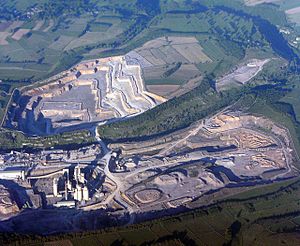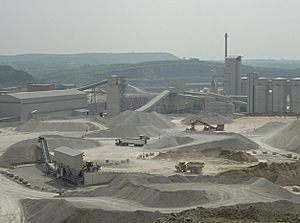Great Rocks Dale facts for kids
Great Rocks Dale is a unique valley in the Derbyshire Peak District in England. It's known as a "dry valley," which means it doesn't have a river flowing through it all the time. This area is famous for its large quarrying operations, where valuable stone is dug out of the ground.
Contents
Discovering Great Rocks Dale's Landscape
The valley stretches from Peak Dale all the way down to Blackwell Mill. This spot is close to Chee Dale and the River Wye.
What is the Valley Made Of?
The main rock here is limestone, which goes very deep, about 380 meters (that's like 1,250 feet!). You can also find special rock formations called "dikes" in this area. Dikes are like walls of rock that cut through other rock layers. They are the only ones of their kind in the White Peak area.
Deep underground, there's a lot of water. Big holes, called Boreholes, are used to bring this water to the surface. Local industries use this water for their work.
How the Valley Looked Before
Before the big quarries started, the valley looked quite different. The southern part was narrow and rocky, with tall limestone cliffs on both sides. The northern part was wider and covered in grass.
A Look at Great Rocks Dale's History
This valley was once part of the mediaeval Forest of High Peak. Around the year 1250, people from a nearby village called Tunstead started farming the land around the dale.
The Railway's Arrival
In 1867, a new railway line was built through the valley. It connected Peak Forest and Millers Dale. This part of the railway is still used today, but only for carrying goods and freight. It's now known as the Great Rocks Line, named after this very area.
The Story of Tunstead Quarry
Today, the valley is mostly known for Tunstead Quarry. This is a very large limestone quarry that started operating in 1929. Because the quarry is so important for the economy, the boundary of the Peak District National Park was carefully drawn to keep the quarry outside the park.
By 1973, Tunstead was the biggest quarry in Europe! There was a debate about letting it expand into the National Park. At first, permission was denied because there was enough stone to last for many years. However, after a lot of discussion and legal cases, the government eventually allowed the quarry to expand into a part of the Peak District National Park.
Tunstead Quarry is still the biggest producer of limestone in the Peak District. About 5.5 million tonnes of limestone are dug out here every year.
Ancient Discoveries and Art
In 1932, workers at the quarry found something amazing. They uncovered a crack in the rock that held the remains of ancient animals. These included bison, Irish elk, and deer. These bones had been washed into the fissure a very long time ago.
Later, in 1957, a painter named Peter Lanyon visited the valley. He studied the quarry walls, seeing them as a way to understand both the Earth's long history and the story of people in the area.



